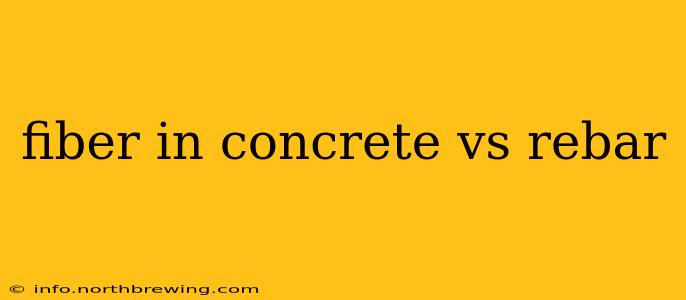Reinforcement is crucial for enhancing the tensile strength and durability of concrete structures. While steel rebar has long been the standard, fiber reinforcement offers a compelling alternative with unique advantages and disadvantages. This comparison explores the key differences between fiber-reinforced concrete (FRC) and rebar-reinforced concrete, helping you understand which option suits your specific needs.
What is Fiber-Reinforced Concrete (FRC)?
Fiber-reinforced concrete incorporates short, discrete fibers—such as steel, polypropylene, glass, or natural fibers—directly into the concrete mix. These fibers improve the concrete's tensile strength, flexural strength, impact resistance, and crack control. The fibers are distributed throughout the concrete matrix, providing a distributed reinforcement system rather than the localized reinforcement offered by rebar.
What is Rebar-Reinforced Concrete?
Rebar-reinforced concrete utilizes steel bars (rebar) placed within the concrete formwork before the concrete is poured. These bars provide localized reinforcement, primarily resisting tensile stresses. The placement of rebar requires careful planning and execution to ensure adequate reinforcement in areas of high stress.
Fiber in Concrete vs. Rebar: Key Differences
| Feature | Fiber-Reinforced Concrete (FRC) | Rebar-Reinforced Concrete |
|---|---|---|
| Reinforcement Type | Distributed, short fibers throughout the concrete mix | Localized, continuous steel bars |
| Tensile Strength | Improved, but generally lower than rebar in high stress | Significantly improved tensile strength |
| Flexural Strength | Significantly improved | Improved, but localized to rebar placement |
| Impact Resistance | Significantly improved | Moderate |
| Crack Control | Excellent, resulting in finer, less pronounced cracks | Good, but cracking can be more significant |
| Workability | Generally easier to place and finish | Requires careful placement and tying of rebar |
| Cost | Can be more cost-effective for certain applications | Often more expensive, especially with complex designs |
| Durability | High durability, particularly against impact damage | High durability, but susceptible to corrosion |
| Corrosion Resistance | Depends on fiber type; some types offer superior corrosion resistance compared to steel rebar | Susceptible to corrosion unless protective measures are taken |
| Applications | Shotcrete, pavements, overlays, precast elements | Buildings, bridges, foundations, and large structures |
What are the advantages of using fiber in concrete?
- Improved impact resistance: FRC significantly surpasses rebar concrete in resisting impact forces. This is vital in applications subjected to impacts or dynamic loading.
- Enhanced crack control: The distributed nature of fibers produces finer, less pronounced cracking, improving the concrete’s overall durability and aesthetic appeal.
- Increased ductility: FRC often demonstrates greater ductility compared to rebar-reinforced concrete, enhancing its ability to withstand deformation.
- Easier placement: The homogeneous nature of FRC simplifies the placement and finishing processes, potentially reducing labor costs.
What are the disadvantages of using fiber in concrete?
- Lower ultimate tensile strength: FRC generally exhibits a lower ultimate tensile strength than rebar-reinforced concrete, limiting its suitability for high-stress applications.
- Fiber orientation: The effectiveness of FRC can be affected by the orientation of fibers during placement.
- Material cost: While sometimes more cost-effective for simpler applications, the cost of some types of fibers can be higher than rebar in certain projects.
What are the advantages of using rebar in concrete?
- High tensile strength: Rebar provides significantly higher tensile strength than fibers, making it ideal for high-stress structures like buildings and bridges.
- Proven technology: Rebar reinforcement is a well-established and understood technology with extensive design guidelines.
- Adaptability to complex designs: Rebar placement can be tailored to meet the specific reinforcement needs of intricate structural designs.
What are the disadvantages of using rebar in concrete?
- Corrosion: Steel rebar is susceptible to corrosion, reducing its lifespan and requiring protective measures.
- Labor intensive: Placing and tying rebar is a labor-intensive process, adding to the overall project cost and time.
- Potential for cracking: While rebar improves tensile strength, significant cracking can still occur in areas of high stress if not properly designed and placed.
When to Use Fiber-Reinforced Concrete vs. Rebar-Reinforced Concrete?
The choice between FRC and rebar-reinforced concrete depends on the specific application and project requirements. FRC is often preferred for applications requiring high impact resistance, improved crack control, and ease of placement, such as pavements, shotcrete applications, and precast elements. Rebar-reinforced concrete remains the standard for applications demanding high tensile strength and where significant loads are involved, such as buildings, bridges, and other large structures. In some cases, a combination of both FRC and rebar can offer the optimal solution.
This analysis provides a comprehensive overview. Consulting with a qualified structural engineer is crucial for determining the appropriate reinforcement method for your specific project.
